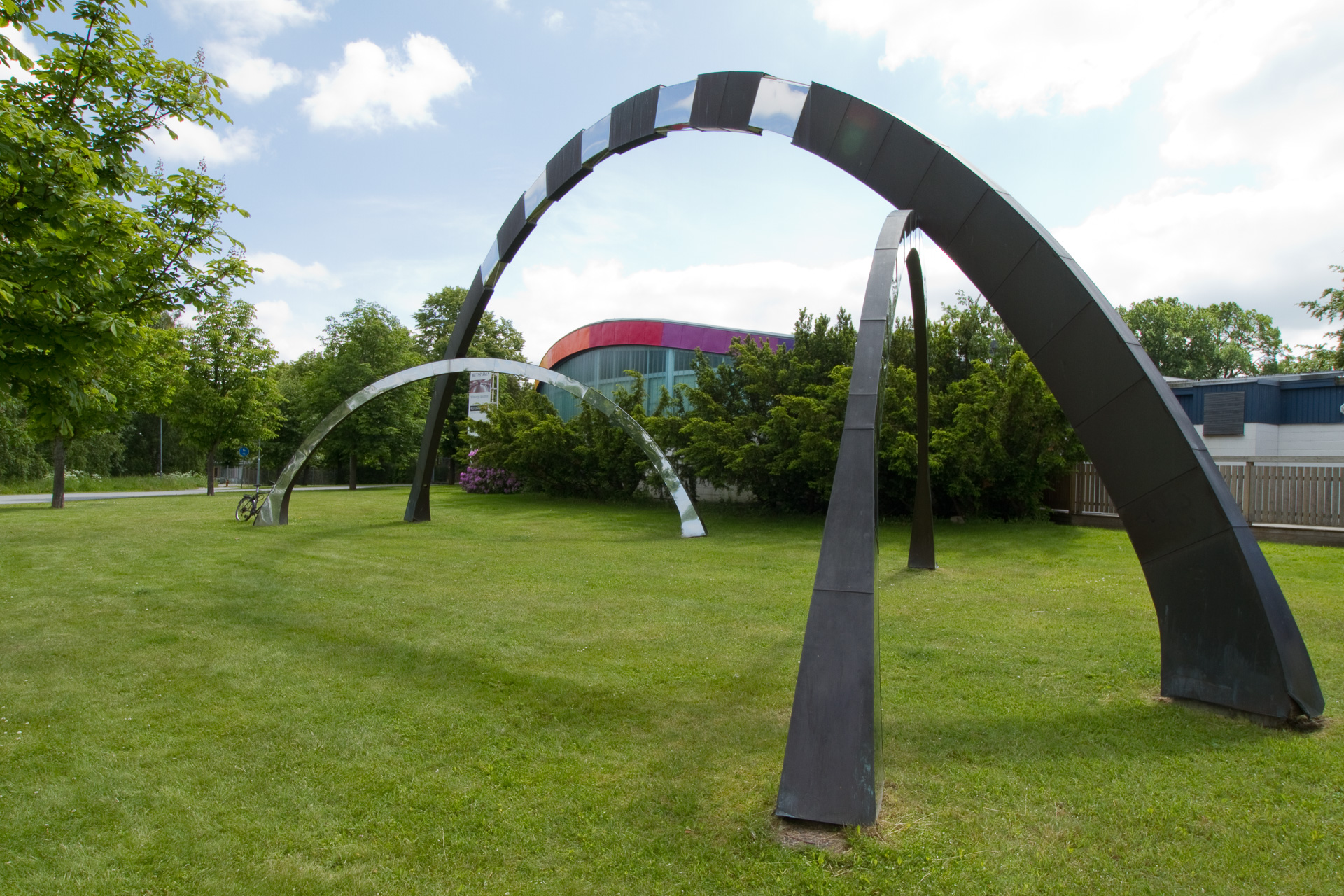Ljusbågen (Electric Arc)
Three large-format arches arch over a lawn in Brunnsparken. They balance on the ends and bend convexly up towards the sky. The largest arc measures about twenty meters between the ends. The two smaller arches are tucked in transversely near each corner under the larger arch. It is difficult to determine whether they are leaning towards it or, on the contrary, supporting it.
The frames are predominantly in dark tones, but the sides of the smaller frames shine with mirror metal and reproduce surrounding colors. On the arches of the larger arch, sections of mirror metal are alternated with copper and neon lights in the colors of the rainbow.

Outside Folkets Park in Brunnsparken, the sculpture Electric Arc by Dascha Esselius has been standing since 1990. The sculpture, which is also a light artwork, consists of three big arcs, the largest of which is 20 metres tall. The work is executed in postmodernist style, with typical material choices such as neon and metallic mirrors.
The largest arc is equipped with neon light, which glows enticingly in red, yellow, green, blue and purple, reminiscent of a rainbow.
The shiny, mirror-like surfaces of the smaller arcs reflect the neon lights from the large arc and mirror colours and motion in their surroundings, for example, from people passing by.
This is what the artist has to say about her work:
‘In 1990, when I was the head teacher in sculpture at Örebro Art College, I was commissioned by Folkets Hus och Parker to create a work that would function as a sort of port of call for Brunnsparken. Because the earmarked budget wasn’t all that big, I decided to submit two different sketches in my proposal. One presented a smaller sculpture that could be executed within the budget. The other sketch presented the sculpture Ljusbågen, which was considerably larger at 7x20x10 metres, and thus wouldn’t fit in the allocated budget, but which in my opinion was needed for the character of the site and purpose of the commission.
The Municipality of Örebro decided to contribute funds so that the Ljusbågen sculpture could be realized. The sculpture was renovated and re-inaugurated in 2019 when ownership was transferred to Örebro.’
Dascha Esselius describes herself as a cross-disciplinary artist. She works with film, photography, sculpture, painting, public art and video installations in her works, which she creates with flows of video projections on layers of transparent veils surrounding the audience. She created one such installation, entitled Ett stycke för ljus och mörker (A Piece for Light and Darkness), at the Art Gallery in Wadköping in 1987.
Konstverk: Ljusbågen (Electric Arc)
Konstnär: Dascha Esselius
År: 1990
Material: Stainless steel mirror, copper, neon
Placering: Brunnsparken, Adolf Mörners plan
Ägare: Örebro Municipality
Konstverkets position på karta
Publicerad:
Tack för ditt svar!
Berätta gärna vad vi kan göra bättre på den här sidan för att förbättra webbplatsen! Vi har ingen möjlighet att svara, men dina synpunkter är värdefulla för oss. Tänk på att inte skicka in personuppgifter. Om du vill ha svar på en fråga kan du istället använda formuläret ”Lämna en synpunkt”.
Om du ändå skickar in personuppgifter via detta formulär hanteras uppgifterna av Kommunstyrelsen och kan eventuellt lämnas vidare till annan verksamhet inom Örebro kommun i syfte att förbättra vår service.
Här hittar du mer information om hur vi hanterar personuppgifter.
Tack för ditt svar!
Du har nu hjälpt oss att förbättra orebro.se
